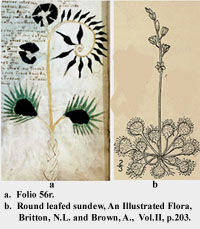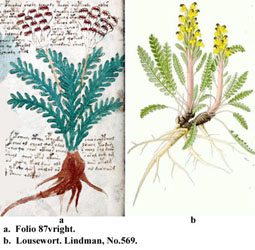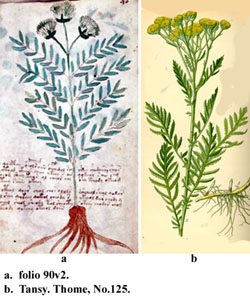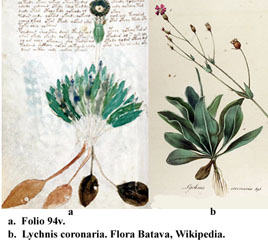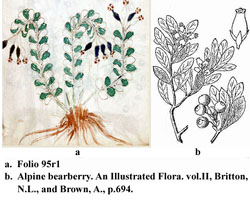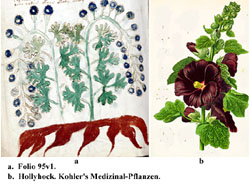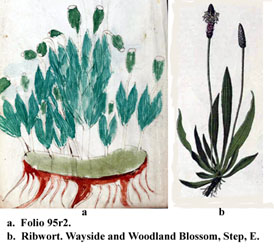The Voynich Botanical Plants
Folio 56r. Round leaf sundew (Drosera rotundifolia) is a carnivorous plant, native to all continents. These plants capture and digest insects using stalked mucilaginous glands that cover their leaf surface. Their leaves are arranged in a rosette, generally flat on the ground. The white flower spike (outlined in blue) is well above the leaves so bees are not trapped. Sundews were used as medicinal herbs as early as the 12th century, when an Italian doctor, Matthaeus Platearius, described the plant as an herbal remedy for coughs under the name "herba sole" This folio was identified by Denis Barthel. (1) (C)
Folio 56v, C Sago Palm (Cycas revoluta) is native to the Old World tropics. However, fossils of this palm have been found on almost every continent on the planet. It is an ancient plant that is either male or female. Folio 56v represents a male sago palm with a dying cone. This palm is very slow growing and the trunk can branch multiple times, thus producing multiple heads of leaves. China is reputed to have a 1,000-year-old sago palm. (C)
Folio 87vright. Lousewort (Pedicularis flammea). This plant grows mainly in cool or temperate climates of the Northern Hemisphere. Linnaeus gave the plant the Latin word for louse as its generic name, due to the belief in medieval times that livestock grazing on the plant got infected with lice, which they passed on to humans. Culpepper believed that “lousewort is accounted profitable to heal fistalas and hollow ulcers and to stay the flux of humours in them as also the abundance of courses and any other fluxes of blood being boiled in port wine and drunk.” (4) (C)
Folio 90v2. Tansy (Tanacetum vulgare). In medieval times, the young leaves of tansy, mixed with eggs, was known as a tansy. It was a favorite dish to celebrate the end of Lent and was supposed to purify the body of bad humours after a long diet of salt fish. It is one of several herbs in a 14th century prescription cure for the plague. (2) (C)
Folio 93r. Artichoke (Cynara cardunculus). Artichokes were cultivated by the Greeks and Romans over two thousand years ago. The blue thistle flowers dry out as they age. The erect stalk has alternate thistle-like leaves. The green paint used to paint the leaves of this VM drawing may have covered up the serrated edges of the leaves. The bud, is the part of the artichoke eaten. It aids digestion, hepatic and gallbladder function and raises the HDL/LDL ratio. (1) (C)
Folio 94v. Rose campion (Lychnis coronaria). This drawing could equally well represent lychnis alpina which, because of its sticky stems, is known as alpine catchfly. (C)
Folio 95r1. Alpine Bayberry (Arctostaphylos alpina). This procumbent shrub is limited in southern Europe to the Pyrenees and the Alps. The fruit, a favorite of bears, is edible and the leaves are used in folk medicine. (1) (C)
Folio 95v1. Hollyhock (Alcea) is a member of the mallow family that was imported into Europe from China. It is a biennial often found growing in clumps. The roots are thick (tuberous), long, and tapering; the leaves are broad and palmate; and the purple, red, pink, or yellow flowers are used to make dyes. They may also be in ingredient in skin moisturizers. (C)
Folio 95r2. Ribwort (Plantago lanceolata) is a perennial European herb with long lance-shaped basal leaves that have 3-5 strong parallel veins. The flower stalks are often more than 2 feet long, terminating in blunt cylindrical spikes. During mediaeval times children used these flower spikes to play a game called kemps. The game involved striking one stalk head against another until one stalk broke. Kemps (cempa) was the Anglo-Saxon word for soldier. Ribwort is used in tisanes that is an effective cough remedy. (1) (C)
